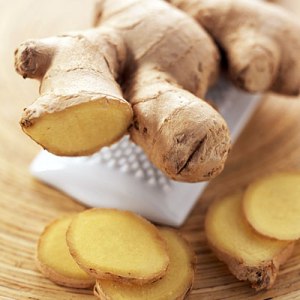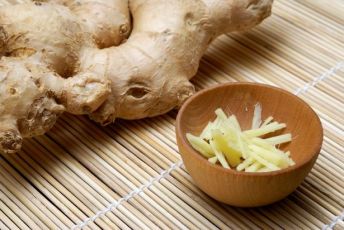 Ginger is an erect perennial herb that has thick tuberous rhizomes (underground stems and roots). It’s botanical name Zingiber officinale, is likely derived from its Sanskrit name, singabera, meaning “horn-shaped.”
Ginger is an erect perennial herb that has thick tuberous rhizomes (underground stems and roots). It’s botanical name Zingiber officinale, is likely derived from its Sanskrit name, singabera, meaning “horn-shaped.”
The rhizome is branched with small “arms” usually two inches in circumference. A piece of the rhizome is often called a “hand.” It has a pale yellow interior and a skin varying in color from brown to off-white.
Jamaican ginger, which is a pale buff, is regarded as the best variety. African and Indian ginger is darker-skinned and generally inferior, with the exception of Kenya ginger, and its flesh can be yellow, red or white in color, depending on the variety.
The brown skin may be thick or thin, depending upon whether the plant was harvested when it was mature or young, respectively.
Ginger rhizome has a firm yet striated texture and boasts a taste that is fragrant, pungent, and hot. Interestingly, according to Chinese tradition, dried ginger tends to be hotter energetically than its fresh counterpart.
Ginger is available in various forms:
- Whole fresh roots. These provide the freshest taste. The roots are collected and shipped when they are still immature; the outer skin is a light green color.
- Dried roots. These are sold either “black” with the root skin left on, or “white” with the skin peeled off. The dried root is available whole or sliced.
- Powdered ginger. This is the buff-colored ground spice made from dried root.
- Preserved or “stem” ginger. This is made from fresh young roots, peeled and sliced, then cooked in a heavy sugar syrup. The ginger pieces and syrup are canned together. They are soft and pulpy but extremely hot and spicy.
- Crystallized ginger. This is also cooked in sugar syrup, then air dried and rolled in sugar.
- Pickled ginger. The root is sliced paper thin and pickled in a vinegar solution. This pickle, known in Japan as がり (gari) often accompanies sushi to refresh the palate between courses.
- Pureed ginger. The root is pureed finely then packed into tubes. This method makes it easy to get exact measurements of ginger with little to no waste, but grating the ginger yourself offers a much fresher product.
History
Ginger is native to southeastern Asia, India, and China, where it has been a very liberal component of the diet. Ginger is found found in ancient Chinese, Indian, and Middle Eastern literature and has long been valued for its aromatic, culinary and medicinal properties. Ginger has also been important in Chinese medicine for many centuries and is mentioned in the writings of Confucius.
 The ancient Romans first imported ginger from China almost 2,000 years ago. From that time its popularity in Europe remained focused in the Mediterranean region until the ninth century. Because ginger had to be imported from Asia, it remained a relatively expensive spice. Nevertheless, it was still in great demand.
The ancient Romans first imported ginger from China almost 2,000 years ago. From that time its popularity in Europe remained focused in the Mediterranean region until the ninth century. Because ginger had to be imported from Asia, it remained a relatively expensive spice. Nevertheless, it was still in great demand.
As a result, Spanish explorers introduced ginger into the West Indies, Mexico, and South America in an effort to increase its availability.
By the sixteenth century, these areas began exporting the precious herb back to Europe. Subsequently it became so popular in Europe that it was included in every table setting, like salt and pepper. A common article of medieval and Renaissance trade, it was one of the spices used against the plague.
In English pubs and taverns in the nineteenth century, barkeepers used to put out small containers of ground ginger for people to sprinkle in their beer -the origins or ginger ale.
In recent times, the top commercial producers of ginger include Jamaica, India, Fiji, Indonesia, and Australia.
Health Benefits
Historically, ginger has a long tradition of being very effective in alleviating symptoms of gastrointestinal distress. In herbal medicine, it is regarded as an excellent carminitive, a substance which promotes the elimination of intestinal gas, and intestinal spasmolytic, a substance which that relaxes and soothes the intestinal tract. These properties can be attributed to its volatile components.
 Modern scientific research has revealed that ginger possesses numerous therapeutic properties which are not limited to those listed above. They include antioxidant effects, an ability to inhibit the formation of inflammatory compounds, and direct anti-inflammatory effects. A combination of ginger, cardamom, cinnamon, and coriander is a great carminative and stimulates digestion.
Modern scientific research has revealed that ginger possesses numerous therapeutic properties which are not limited to those listed above. They include antioxidant effects, an ability to inhibit the formation of inflammatory compounds, and direct anti-inflammatory effects. A combination of ginger, cardamom, cinnamon, and coriander is a great carminative and stimulates digestion.
Ginger is also one of the best treatments for motion sickness, nausea, morning sickness, and sea sickness. In studies it has been shown to perform more effectively than Dramamine in preventing and treating motion sickness, and it doesn’t cause drowsiness and other side effects. It works by slowing the feedback interaction between the stomach and nausea center of the brain by absorbing and neutralizing gastrointestinal hormones, toxins, and acids. This is a much more healthy cycle than impairing the central nervous system to prevent drowsiness like Dramamine.
People who suffer with rheumatoid arthritis, muscle pain, and osteoarthritis have found success in inflammation and pain relief even where drugs have failed. The best part about ginger is that you can receive these benefits from cooking with it. It is high in active chemicals so eating as little as a 1/4 inch slice of ginger daily has shown results. It can also be made into a delicious tea which is quite enjoyable and easy to prepare.
Energetic and Magical Properties
 Gender: Masculine
Gender: Masculine
Planet: Mars
Element: Fire
Influences: Love, Money, Success, Power, Protection
Ingesting ginger before working magic or healing is most favorable. The root helps to stimulate energy flow throughout the body, and makes your store of personal power more readily available.
When parts of the root are worn or carried it is said to protect the wearer from harm; the same is true if planted in gardens.
Sprinkling dried ginger powder onto money or into your wallet helps to attract funds.
Love spells and potions of all types include ginger because it warms hearts and increases passion.
In the Pacific the Dobu islanders make much use of ginger in their magic. They chew it and spit it at the “seat” of an illness to cure it, and also spit chewed ginger at an oncoming storm to calm it.
When used in cooking magic ginger can bring health, vibrant energy, and zeal into your dishes. Simply ask the ginger to impart your food with its properties as you add it to your creations. This is especially helpful if there is a lingering illness or imbalance within your household.
How to Select and Store
Fresh ginger can be purchased in the produce section of most supermarkets. Ginger is generally available in two forms, either young or mature. Mature ginger, the more readily available type, has a tough skin which requires peeling, while young ginger, usually available only in Asian markets, need not be peeled. Fresh ginger can be stored in the refrigerator for up to three weeks if left unpeeled.
 Whenever possible, choose fresh ginger over dried since it is not only superior in flavor but also contains higher levels of gingerol as well as ginger’s active protease, its anti-inflammatory compound.
Whenever possible, choose fresh ginger over dried since it is not only superior in flavor but also contains higher levels of gingerol as well as ginger’s active protease, its anti-inflammatory compound.
The bronze root should be fresh looking, with no signs of decay such as soft spots, mildew, or a dry, wrinkled skin. When purchasing fresh ginger, make sure it is firm, smooth, and free of mold.
If fresh ginger is not available, dried ginger is widely stocked. Just as with other dried spices, when purchasing dried ginger powder, try to select organically grown ginger, since organic spices are less likely to have been irradiated.
Ginger is also available in several other forms, including crystallized, candied, pickled and pureed. It can be found in the first three forms in Asian markets and natural food stores. Pureed ginger is becoming readily available at supermarkets. Simply look for the tube in the refrigerated produce section.
Dried ginger powder should be kept in a tightly sealed glass container in a cool, dark and dry place for no longer than six months.
Tips for Use
A paring knife is the best utensil to remove the skin from young ginger, while a spoon is quite handy for mature ginger. Simply scrape the skin off with the edge of the spoon, and make sure to get into all the little crevices.
 It is important to note that the strength and taste that ginger imparts to a dish depend upon its timely addition during the cooking process. If it is added at the beginning, it will create a subtler taste; however, if you add it near the end, it will be much more pungent.
It is important to note that the strength and taste that ginger imparts to a dish depend upon its timely addition during the cooking process. If it is added at the beginning, it will create a subtler taste; however, if you add it near the end, it will be much more pungent.
Ginger is an important spice in cooked dishes but can also be used as a fantastic addition to fresh fruit and vegetable juices, especially pineapple, carrot, and apple.
*Safety*
Ginger contains moderate amounts of oxalate. Individuals with a history of oxalate-containing kidney stones should avoid over-consumption of this spicy root.
Nutritional Information per 100 Gram Serving
Calories: 347
Carbohydrates: 70.79 g
Fat: 5.95 g
Protein: 9.12 g
Fiber: 12.5 g
Water: 9.38 g
Stearic Acid: 0.025 g
Oleic Acid: 1 g
Linoleic Acid: 1.02 g
Linolenic Acid: 0.29 g
Arachidonic Acid: 0 g
EPA: 0 g
DHA: 0 g
Cholesterol: 0 mg
Monounsaturated Fat: 1 g
Polyunsaturated Fat: 1.31 g
Saturated Fat: 1.94 g
Calcium: 116 mg
Copper: 0.48 mg
Iron: 11.52 mg
Magnesium: 184 mg
Manganese: 26.5 mg
Phosphorous: 148 mg
Potassium: 1343 mg
Selenium: 38.5 mg
Sodium: 32 mg
Zinc: 4.72 mg
Folic Acid: 0 mcg
Niacin: 5.155 mg
Pantothenic Acid:0 mg
Riboflavin: 0.185 mg
Thiamine: 0.046 mg
Vitamin A: 147 IU
Vitamin B12: 0 mcg
Vitamin B6: 0.84 mg
Vitamin C: 7 mg
Vitamin E:0.28 mg
Vitamin K: 0 mg
Recipes which Include Ginger:
Ginger Tea (생강차 [Saenggangcha])
This article was adapted from:
The Encyclopedia of Healing Foods by Michael Murray N.D. and Joseph Pizzorno N.D. with Lara Pizzorno M.A. , L.M.T.
With Additional Information from:
The Master Book of Herbalism by Paul Beyerl
Cunningham’s Encyclopedia of Magical Herbs by Scott Cunningham
The Herb Book by John Lust
Pictures pulled from Google.com except for picture of peeled ginger which belongs to Maangchi.com